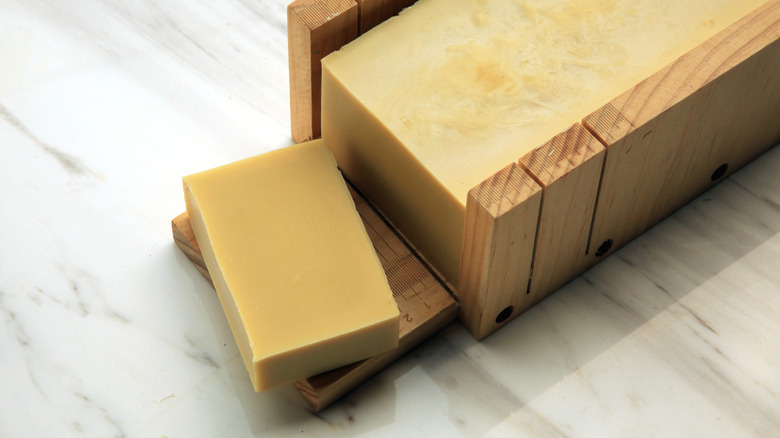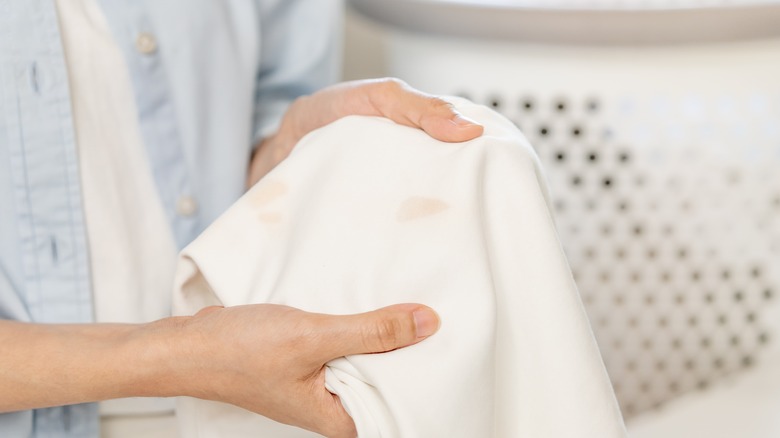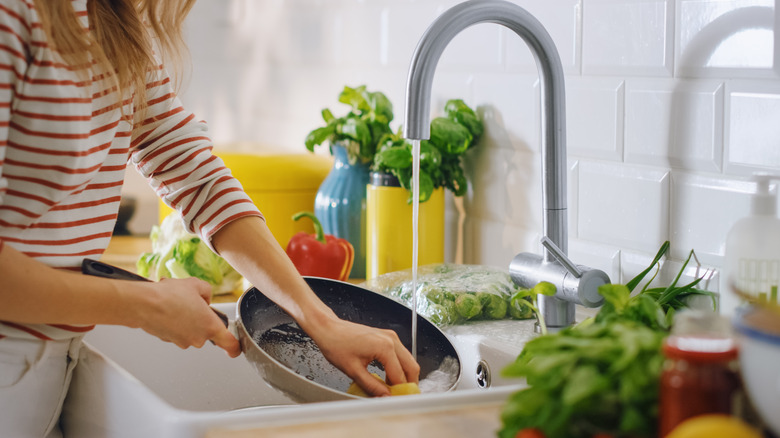To Cut Through The Toughest Of Grease, Look No Further Than Castile Soap
The enemies of laundry room fighters and kitchen warriors often overlap and none more so than the dreaded grease stain. One minute you're innocently frying up strips of salty bacon — the tofu kind, for the vegetarian crowd — and the next, you're frantically dabbing grease splatter off your favorite loungewear in vain. At this point, you may be tempted to throw in the towel but fret not. When your go-to grease removers just aren't cutting it, reach for Castile soap instead.
Castile soap is one of those magical home cleaning items that can do a lot with a little. The most popular brand by far is Dr. Bronner's. It comes in a liquid or bar option, and the reason it can tackle tough grease stains so well lies in its ingredients.
According to Dr. Bronner's, two key components used in the production of soap are fat, either animal or something plant-based; and potassium hydroxide or sodium hydroxide, the latter of which is commonly known as lye. Though the term "lye" sounds off-putting at best, that particular ingredient is not in the final product. It's only used in the production phase to cause a scientific reaction and turn the fat into the ultimate stain, grime, and grease fighter. Castile soap, specifically, is made from a high-fat plant oil that prevents lye from sticking around. When the finished product mixes with water, it forms a substance that's able to capture grease until it all gets hauled off with a good rinse.
Castile soap benefits
The traditional fat used in Castile soap is olive oil, though many brands now utilize other vegetable-based options like avocado oil or coconut oil. Really though, the true beauty of Castile soap is found in its lack of ingredients. It's free of chemicals and synthetic additives or preservatives. Because of this, Castile soap is much kinder on the skin than other cleaners, and it's safe to use around pets. It's even hypoallergenic in its purest form and only becomes an issue for allergy sufferers when infused with essential oils.
Unlike with other cleaning products, you don't have to use half a bottle of Castile soap to get the job done. Most recommended household uses, such as clothes washing or mopping, only call for a half cup or less when mixed with water. You'd only need a drop or two to spot-scrub grease stains or when putting the cleaner to work in smaller ways. A half gallon of pure Castile soap will last you a while, and it will likely be cheaper than other, less natural cleaning products of the same size.
Other uses for Castile soap
Once you purchase that large bottle, you'll want to find ways to put it to work. Luckily, Castile soap is incredibly versatile. We've mentioned utilizing it in the laundry room and on your floors, be they hardwood, stone, granite, or marble. And, of course, on grease stains, though you don't have to limit that use to just the pesky splotches on your clothes. Mix Castile soap and water in a squirt bottle and you can degrease all parts of your kitchen, from the stove to the cabinets and counters. That said, it's advised to avoid especially shiny or hard surfaces. It's a soap, after all, and can leave behind a slight residue. Other kitchen uses include turning the cleaner into an organic fruit and vegetable wash or as a substitute for dish soap.
Along with cleaning your house, you can clean your body with Castile soap, too. It makes for a great face, body, hand, and hair wash. Only those without color-treated hair should use it as a shampoo, though. Some even swap their toothpaste with peppermint-infused Castile soap since it's fluoride-free.


